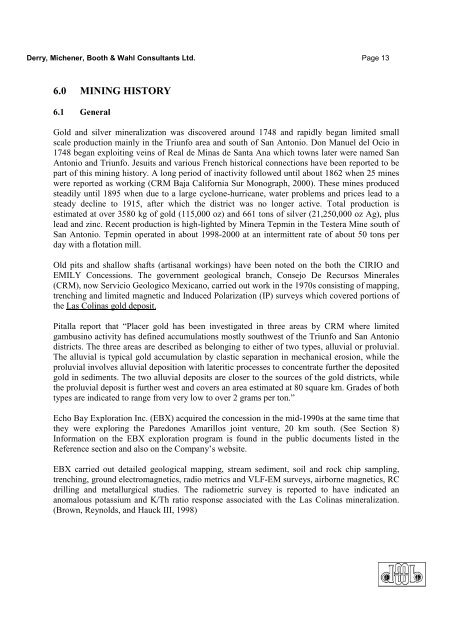43-101 2007 Technical Report On The San Antonio Project, Baja ...
43-101 2007 Technical Report On The San Antonio Project, Baja ...
43-101 2007 Technical Report On The San Antonio Project, Baja ...
You also want an ePaper? Increase the reach of your titles
YUMPU automatically turns print PDFs into web optimized ePapers that Google loves.
Derry, Michener, Booth & Wahl Consultants Ltd. Page 136.0 MINING HISTORY6.1 GeneralGold and silver mineralization was discovered around 1748 and rapidly began limited smallscale production mainly in the Triunfo area and south of <strong>San</strong> <strong>Antonio</strong>. Don Manuel del Ocio in1748 began exploiting veins of Real de Minas de <strong>San</strong>ta Ana which towns later were named <strong>San</strong><strong>Antonio</strong> and Triunfo. Jesuits and various French historical connections have been reported to bepart of this mining history. A long period of inactivity followed until about 1862 when 25 mineswere reported as working (CRM <strong>Baja</strong> California Sur Monograph, 2000). <strong>The</strong>se mines producedsteadily until 1895 when due to a large cyclone-hurricane, water problems and prices lead to asteady decline to 1915, after which the district was no longer active. Total production isestimated at over 3580 kg of gold (115,000 oz) and 661 tons of silver (21,250,000 oz Ag), pluslead and zinc. Recent production is high-lighted by Minera Tepmin in the Testera Mine south of<strong>San</strong> <strong>Antonio</strong>. Tepmin operated in about 1998-2000 at an intermittent rate of about 50 tons perday with a flotation mill.Old pits and shallow shafts (artisanal workings) have been noted on the both the CIRIO andEMILY Concessions. <strong>The</strong> government geological branch, Consejo De Recursos Minerales(CRM), now Servicio Geologico Mexicano, carried out work in the 1970s consisting of mapping,trenching and limited magnetic and Induced Polarization (IP) surveys which covered portions ofthe Las Colinas gold deposit.Pitalla report that “Placer gold has been investigated in three areas by CRM where limitedgambusino activity has defined accumulations mostly southwest of the Triunfo and <strong>San</strong> <strong>Antonio</strong>districts. <strong>The</strong> three areas are described as belonging to either of two types, alluvial or proluvial.<strong>The</strong> alluvial is typical gold accumulation by clastic separation in mechanical erosion, while theproluvial involves alluvial deposition with lateritic processes to concentrate further the depositedgold in sediments. <strong>The</strong> two alluvial deposits are closer to the sources of the gold districts, whilethe proluvial deposit is further west and covers an area estimated at 80 square km. Grades of bothtypes are indicated to range from very low to over 2 grams per ton.”Echo Bay Exploration Inc. (EBX) acquired the concession in the mid-1990s at the same time thatthey were exploring the Paredones Amarillos joint venture, 20 km south. (See Section 8)Information on the EBX exploration program is found in the public documents listed in theReference section and also on the Company’s website.EBX carried out detailed geological mapping, stream sediment, soil and rock chip sampling,trenching, ground electromagnetics, radio metrics and VLF-EM surveys, airborne magnetics, RCdrilling and metallurgical studies. <strong>The</strong> radiometric survey is reported to have indicated ananomalous potassium and K/Th ratio response associated with the Las Colinas mineralization.(Brown, Reynolds, and Hauck III, 1998)











